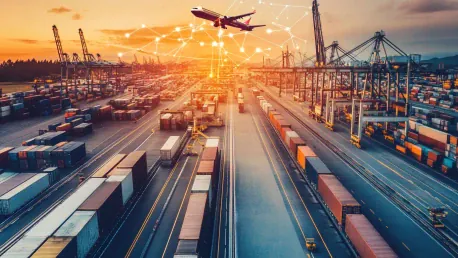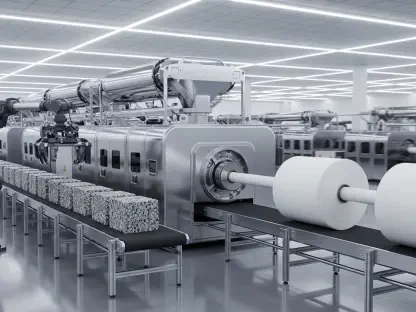The ever-evolving landscape of global supply chains is subject to major influences such as fluctuating tariffs, the integration of artificial intelligence (AI), and the increasing push for sustainable practices. The ramifications of tariffs, technology advancements, and sustainability efforts are profoundly altering the way businesses navigate and optimize their supply chains. Examining these elements reveals the multifaceted challenges and opportunities for supply chain management.
Navigating the Complexities of Tariffs
Understanding the economic consequences of tariffs, especially those introduced by the Trump administration, is crucial for supply chains. Tariffs can lead to increased consumer prices for various goods, including electronics, automobiles, clothing, and household products. This impact disrupts the market balance, shifting the cost burden onto consumers and complicating sales strategies for companies.
While domestic producers might seem to benefit from reduced foreign competition, tariffs often result in higher production costs if they rely heavily on imported components. These increased costs can shrink profit margins, necessitating significant adjustments in consumer pricing or modifications to product offerings. Consequently, domestic manufacturers must weigh the enhanced competitive position against the financial strain imposed by elevated production expenses.
A significant concern among manufacturing and supply chain leaders remains the escalation of trade wars. Such conflicts can further complicate the seamless flow of goods into and out of the U.S. In the face of heightened economic tension, industry leaders have been reporting trade wars as a major issue, an anxiety unlikely to abate soon. To counteract these negative effects, there is an urgent need to embed resiliency into the supply chain by diversifying suppliers across different regions and reducing reliance on scarce resources, thus securing a more stable and adaptable supply chain framework.
Trade Wars and Strategic Responses
In the current climate, the threat of escalating trade wars adds additional complexity to supply chain management. Trade tensions can result in tariff impositions and retaliations, making international trade more cumbersome and costly. The unpredictability of these trade dynamics places a strain on businesses, and 89% of industry leaders have identified this as a central issue.
To mitigate the impact of these trade conflicts, businesses are advised to embed resilience into their supply chains. This may involve diversifying their suppliers across various geographic regions, reducing dependence on any single country or resource. By broadening their supplier base, companies are better positioned to navigate interruptions and maintain operational efficiency even amidst international frictions.
Strategic responses also call for leveraging technology to predict and manage risks. Predictive analytics enabled by AI can offer crucial insights into potential supply chain disruptions, allowing companies to take pre-emptive measures. This proactive approach to managing supply chains not only buffers against the fallout of trade wars but also ensures smoother operation despite external pressures.
The Role of AI in Supply Chains
Artificial Intelligence (AI) has transitioned from being a burgeoning technology to a critical component in supply chain operations, poised to scale across various operational areas. AI’s adoption is tremendously beneficial in areas such as predictive maintenance, inventory management, procurement, and workforce productivity. This integration brings a level of end-to-end visibility that is essential for modern supply chains.
End-to-end visibility enables companies to identify bottlenecks, inefficiencies, and risks within their supply chains. With AI, businesses can gather real-time data, analyze trends, and make informed decisions that enhance overall supply chain resilience. AI-powered systems predict maintenance needs, thereby reducing downtime and increasing the efficiency of operations.
Moreover, AI tools enhance inventory management by optimizing stock levels and minimizing excesses and shortages. This streamlined approach ensures that resources are correctly allocated, reducing waste and improving the bottom line. By automating procurement processes, AI also improves accuracy and speeds up transaction times, leading to a more efficient supply chain.
Workforce Benefits and Challenges
The introduction of AI into supply chains also brings significant impacts on the workforce. While there are concerns about potential job displacement, AI opens up opportunities for workers to engage in higher-skill roles that require innovative problem-solving. Job roles evolve from repetitive tasks to more complex and creative functions, leading to enhanced job satisfaction and productivity.
AI helps in reducing operational costs, improving product quality, and boosting competitiveness, all of which are crucial given the dynamic and demanding nature of current industry conditions. AI’s ability to streamline operations reduces the likelihood of human error, yielding better quality control and consistency. This technological advancement ensures companies remain competitive in a market where efficiency and innovation are paramount.
Despite fears of automation-induced unemployment, AI can significantly augment the workforce. For instance, predictive maintenance and AI-optimized scheduling lead to fewer breakdowns and more streamlined workflows, leaving workers to focus on areas that require human judgment and creativity. Thus, AI proves to be a tool for empowerment rather than replacement.
Push for Sustainability
Sustainability has emerged as a vital focus for manufacturers worldwide. This drive is fueled by public and private sector investments aimed at reducing the ‘green premium’ – the additional cost associated with sustainable practices. One strategy to promote greener supply chains is reshoring manufacturing back to the U.S., which can significantly reduce transportation emissions and costs while taking advantage of clean technologies to improve energy efficiency.
Government incentives such as the Inflation Reduction Act (IRA) and the CHIPs Act provide financial benefits that further encourage sustainable practices. These initiatives support manufacturers in adopting greener technologies by offsetting some of the costs, making it more feasible for companies to implement sustainable solutions without compromising profitability.
Reshoring also streamlines operations, making them more efficient and less reliant on complex global supply networks. This localization reduces the carbon footprint and supports sustainability goals. Manufacturers can integrate clean energy sources and more sustainable materials into their production processes, contributing to a greener supply chain and potentially attracting environmentally-conscious consumers.
Balancing Costs and Sustainability
The tension between advancing sustainability efforts and optimizing costs remains a significant challenge for many manufacturers. Though reducing the green premium makes sustainable solutions more accessible, the initial investment can be substantial. However, over time, the benefits of adopting sustainable practices, such as reduced energy consumption and improved operational efficiency, often lead to long-term cost savings.
Balancing these elements requires strategic planning and investment. Manufacturers must analyze their processes to identify areas where sustainability can be integrated cost-effectively. Embracing technologies such as AI can facilitate this by optimizing energy use, reducing waste, and streamlining supply chain operations. These measures reduce costs while advancing sustainability goals.
Sustainability efforts, complemented by reshoring and government incentives, are poised to create greener and more efficient supply chains. Companies that successfully integrate these practices will likely find themselves at a competitive advantage, able to meet regulatory requirements and cater to the growing market of environmentally conscious consumers.
On-Demand Manufacturing
On-demand manufacturing has emerged as a pivotal solution for cost reduction and operational efficiency, particularly in regulated sectors such as automotive, aerospace, and medical device manufacturing. This model allows companies to produce goods in response to actual demand rather than anticipated needs, minimizing waste and reducing inventory costs.
Technological solutions play a crucial role in facilitating on-demand manufacturing. Tools like 3D printing and advanced robotics enable faster product development and enhanced product quality, allowing manufacturers to swiftly respond to market needs. These technologies also support better sourcing options, ensuring that materials are used efficiently and sustainably.
In addition to cost savings, on-demand manufacturing helps companies maintain profitability amidst various pressures, including economic headwinds, climate risks, and geopolitical tensions. By aligning production closely with consumer demand, businesses can better navigate the uncertainties characteristic of today’s global market, ensuring both operational and financial resilience.
Optimizing Supply Chains
The dynamic landscape of global supply chains continues to evolve, heavily influenced by factors such as changing tariffs, the integration of artificial intelligence (AI), and the growing emphasis on sustainable practices. These elements are reshaping the way businesses manage and optimize their supply chains in significant ways. Fluctuating tariffs can impact costs and sourcing decisions, compelling companies to adapt their strategies to stay competitive. The integration of AI presents opportunities for increased efficiency, predictive analytics, and automation, helping businesses streamline their supply chain operations. Meanwhile, there is a concerted push for sustainability, prompting firms to adopt greener practices, reduce their carbon footprints, and ensure ethical sourcing. These advancements are creating a complex web of challenges and opportunities that supply chain managers must navigate. By examining these critical influences, one can gain a deeper understanding of the current state and future trajectory of supply chain management, balancing efficiency, and innovation with ethical and environmental considerations.









